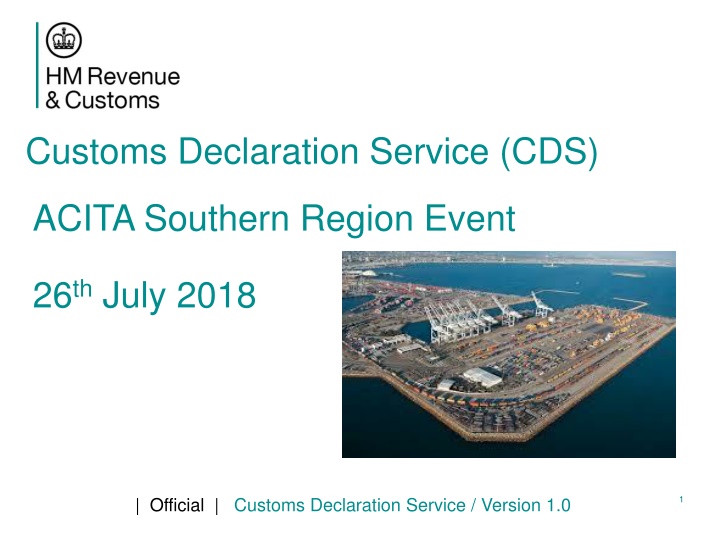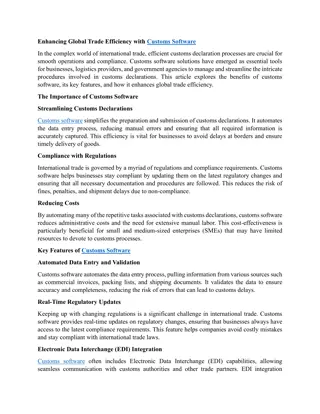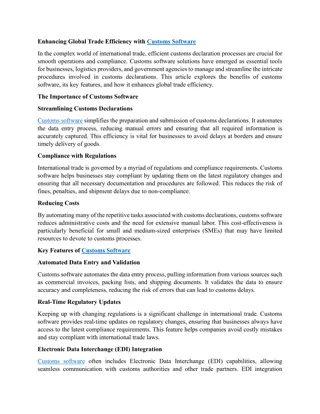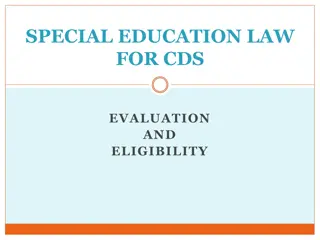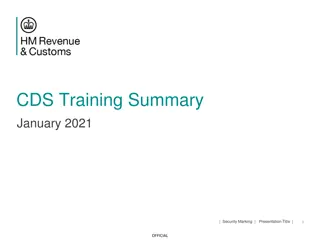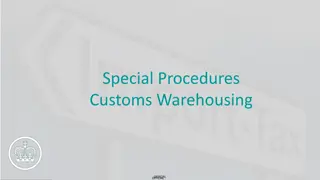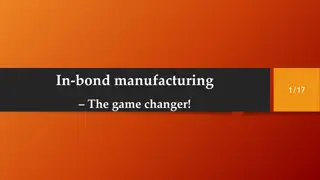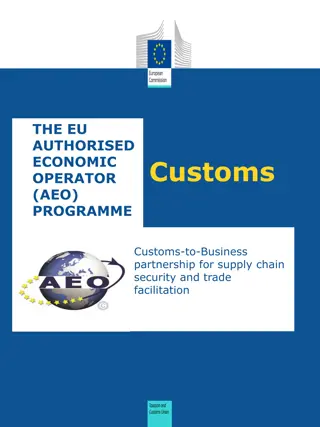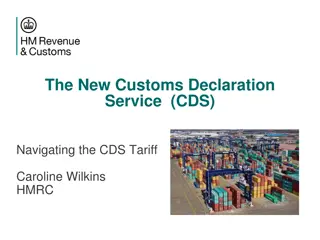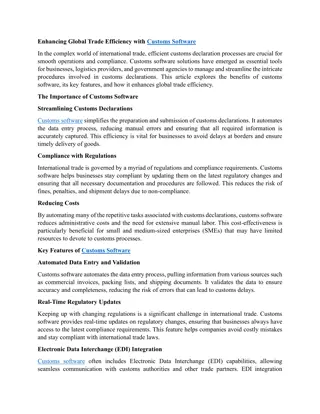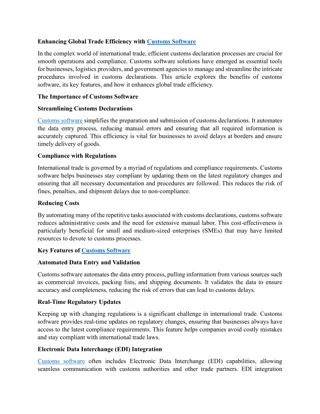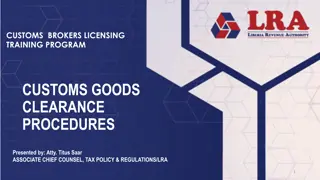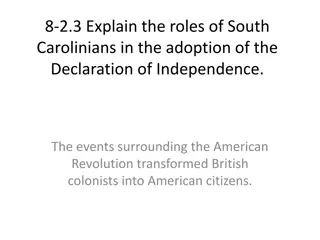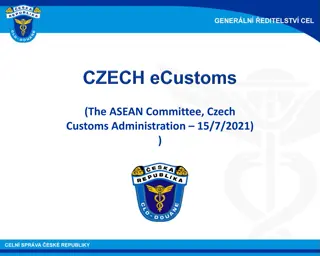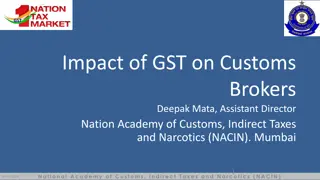Changes Introduced by Customs Declaration Service (CDS)
The Customs Declaration Service (CDS) brings significant changes, shifting from EDIFACT to XML format, enhancing technical communication methods, transitioning to digital reporting, and updating tariff publication guidelines. It requires completion using data elements instead of box numbers, allowing more items per declaration, and enforcing protective marking classifications.
Download Presentation

Please find below an Image/Link to download the presentation.
The content on the website is provided AS IS for your information and personal use only. It may not be sold, licensed, or shared on other websites without obtaining consent from the author.If you encounter any issues during the download, it is possible that the publisher has removed the file from their server.
You are allowed to download the files provided on this website for personal or commercial use, subject to the condition that they are used lawfully. All files are the property of their respective owners.
The content on the website is provided AS IS for your information and personal use only. It may not be sold, licensed, or shared on other websites without obtaining consent from the author.
E N D
Presentation Transcript
Customs Declaration Service (CDS) ACITA Southern Region Event 26th July 2018 1 | Official | Customs Declaration Service / Version 1.0
What changes with CDS? Technical - From EDIFACT to XML Protective marking Unclassified, Protect, Restricted (delete as required)
What changes with CDS? - Technical No E-mail option Communication via internet APIs sending a message directly to an IP address Responses can be pushed or pulled Access via CSP doesn t change No HCI Some CSPs will present a screen (built on API) Some will tell you to use an HMRC Digital service (like NES) Access Security via OAuth2 tokens (see later) CSP can still use the Badge Protective marking Unclassified, Protect, Restricted (delete as required)
What changes with CDS? - Technical Receiving reports Digital Dashboard MSS, Duty Deferment Statements, VAT Certs Receiving reports E2s etc No paper No reports , only notification messages Any reports will be created by your software, as needed No HCI Some CSPs will present a screen (built on HMRC APIs) Some CSPs will tell you to use an HMRC Digital service (like NES) Protective marking Unclassified, Protect, Restricted (delete as required)
CDS Tariff publication Declaration completion guidelines and rules published in the Tariff Volume 3 - Imports Volume 3 - Exports Volume 3 - Imports Inventory Release Volume 3 - Exports Inventory Release CDS Tariff Manual Import Tariff March 18. Contains all Imports CPC codes except those for inventory linking. Printed version August. Searchable PDF version available now. Exports Tariff and Inventory Linking limited draft since early July 18. Remaining CPCs. Tariff includes CHIEF/CDS code mappings. Protective marking Unclassified, Protect, Restricted (delete as required)
Changes introduced by CDS Tariff Declarations will require completion using Data elements, rather than by box number. Split into 8 data groups Procedure codes formerly called Customs Procedure Codes will be split into 2 parts Harmonisation of codes set out in Law and Appendices An audit trail of previous document ID s (MUCR, DUCR and MRN), EPU s will be invalid Increased number of items allowed per declaration from 99 to 999 Protective marking Unclassified, Protect, Restricted (delete as required)
Changes introduced by CDS Tariff To fill in the declaration, you will be required to select a declaration Category that will provide the data set to be followed (Supp Decs = H1) Declaration Types, determine along with the declaration Category, the data set to be followed and dictate specific business rules Greater number of Data Elements than Box numbers External users access via Gov.uk Submit Declarations, Obtain real time information and reports and view duty deferment accounts No longer have to pay for MSS Data Protective marking Unclassified, Protect, Restricted (delete as required)
Reading the CDS Tariff - Import Declaration Completion Guide No. of occurrences at header level 1x No. of occurrences at item level 99x Declaration Categories Field format C21, H1, H2, H3, H4, H5 & I1 a2 Which types of declaration require the completion of the data element Declaration Categories The number and type of characters allowed in the field Field format The number of times the data element may be used at header level Number of occurrences at header level Number of occurrences at item level The number of times the data element may be used at item level Protective marking Unclassified, Protect, Restricted (delete as required)
Declaration Categories Declaration Title Requested Declaration Category Procedure Codes(CPC s) (Digits 1 and 2) 01, 07, 40, 42, 44, 61 Declaration for release for free circulation or end-use H1 Declaration for customs warehousing Declaration for temporary admission Declaration for inward processing Declaration for goods from the special fiscal territories 71 H2 53 H3 51 H4 40, 42, 61 H5 Import Simplified Declaration 01, 07, 40, 42, 44, 51, 53, 61, 71 I1 Protective marking Unclassified, Protect, Restricted (delete as required)
What changes with CDS? - Business Data Elements not SAD Box numbers The data elements are in 8 groups; Group Description 1 Message Information (including Procedure Codes) 2 References of Messages, Document, Certificates and Authorisations 3 Parties 4 Valuation Information and Taxes 5 Dates, Times, Periods, Places, Countries and Regions 6 Goods Identification 7 Transport Information (Modes, Means and Equipment) 8 Other Data Elements (Statistical Data, Guarantees and Tariff Related Data) Protective marking Unclassified, Protect, Restricted (delete as required)
Follow UK Trade Tariff, CDS Volume 3 Import Declaration Completion Guide H1 Removal from Customs Warehouse using Entry In Declarants Records Group 6 D.E 6/1 Net Mass (KG) (SAD box 38) D.E 6/5 Gross Mass (KG) (SAD box 35) D.E 6/ 9 Type of packages (SAD box 31) D.E 6/10 Number of packages (SAD box 31) D.E 6/11 Shipping Marks (SAD box 31) D.E 6/18 Total Packages (SAD box 6) Group 1 D.E. 1/6 Goods Item number (SAD box 32) D.E 1/9 Total number items (SAD box 5) Group 5 D.E. 5/8 Country of Destination Code (SAD box 17a) D.E. 5/14 Country of dispatch (SAD box 15a) D.E 5/15 Country of origin code (SAD box 34a) D.E 5/23 Location of goods (SAD box 30) Group 7 D.E 7/2 Container (SAD box 19) D.E 7/4 Mode of transport at Border (SAD box 25) D.E 7/10 Container identification number (SAD box 31) D.E 7/15 Nationality of active means of transport crossing the border (SAD box 31(2)) Group 2 D.E. 2/1 Simplified Declarations/ Previous documents (SAD box 40) D.E. 2/5 LRN (SAD box N/A) D.E.2/7 Identification of warehouse SAD box 49) Group 4 D.E. 4/1 Delivery Terms (SAD box 20) D.E. 4/8 Calculations of taxes- MOP (SAD box 47) D.E. 4/10 Invoice Currency (SAD box 22(1)) D.E. 4/13 Valuation Indicators (SAD box 45) D.E. 4/14 Item Price Amount (SAD box 42) D.E. 4/16 Valuation Method (SAD box 43) D.E. 4/17 Preference (SAD box 36) Group 3 D.E. 3/16 Import ID number (SAD box 8) D.E.3/17 Declarant (SAD box 14) D.E. 3/39 Holder of the authorisation ID number (SAD box 44) Group 8 D.E 8/2 Guarantee Type (SAD box 52) D.E 8/3 Guarantee Reference Number (SAD box 52) D.E 8/5 Nature of transaction (SAD box 24)
What changes with CDS? Customs Procedure Codes now in two parts D/E 1/10 - 4 digit Procedure Code, plus D/E 1/11 - (multiple) 3 character Additional Codes Protective marking Unclassified, Protect, Restricted (delete as required)
What changes with CDS? Customs Procedure Codes now in two parts D/E 1/10 - 4 digit Procedure Code, plus D/E 1/11 - (multiple) 3 character Additional Codes Protective marking Unclassified, Protect, Restricted (delete as required)
What changes with CDS? More UCC changes Methods of Payment code harmonisation Validation of authorisations, guarantees, BTIs etc More Parties (buyer, seller etc) Incoterms, Nature of Transaction codes, Valuation codes EIDR is simpler can move goods under warehouse CPC so SFDs needed less often Protective marking Unclassified, Protect, Restricted (delete as required)
What changes with CDS? FEC checks Can now do TARIC checks (Q1/Q2 ratio, check Quantity matches Comm code restrictions) Other FEC checks are now non blocking Declaration clears after a 10-minute dwell time Change in approach to post-clearance compliance Can do more in future eg behavioural analysis Protective marking Unclassified, Protect, Restricted (delete as required)
Exports changes for CDS Some key functional areas of CDS exports will differ from today Frustrated exports Arrival post departure and multiple departures Amendments and Cancellation ROE code mapping Topic Types and Customs Position Reason Types (SOE/ICS codes) DUCR part numbers Assumed departure 17 Protective marking Unclassified, Protect, Restricted (delete as required)
International Trade Development Liaison Officer - ITDLOs National ITDLO Manager East Croydon Currently Three ITDLOs Bristol, Glasgow and Leeds Agreement to increase from three to thirteen in the next three years. One in each Regional Centre Location. Main role: To promote new developments within customs and international trade to businesses and colleagues New developments include changes to existing customs law such as the UCC and trade preparation for CDS and EU Exit The ITDLO s Are currently working on a Special Procedures presentation - available soon Heavily involved with CDS delivery including writing and delivering presentations We have been promoting and explaining about AEO since it started in 2008 . And of course once the UK has an agreement (or not) with the EU, the ITDLOs will be explaining this to Importers and Exporters .
CDS Phased Delivery & Migration Overview Commencing in August 2018 there will be a phased migration of traders from CHIEF to CDS, aligned to the planned delivery of CDS functionality. Migration tranches Customers will be migrated in tranches which will be aligned to functional releases. Tranches are groups of traders. Functional releases Release 1 12th August 18 Scope: Supplementary declaration functionality (Out of Customs Warehouse / Into Free Circulation - Type Z and Y). Specific criteria applies eg deferred payment only, on single DAN; only UK warehouses; no quotas, suspensions or reliefs. Customs Declaration Service | 2 0
CDS Phased Delivery & Migration Overview Functional releases Release 2 November 18 Scope: Remaining import functionality including support for Quota and multiple deferment accounts on a declaration. No immediate payments or securities; limited Digital services Release 3 TBC Scope: All exports, all other methods of payment, Digital self-service. Ability to send Exports Inventory Linking requests to CDS will be in place before the first CDS exports declarations. Customs Declaration Service | 2 1
CDS Phased Delivery & Migration Overview Phase 2 functionality Once core functionality is available in CDS and all customers have migrated, further releases in 2019 will offer service improvements This will include additional Digital services and APIs, better control of Authorisations (e.g. who can claim IPR on your behalf) post-clearance automation Customs Declaration Service | 2 2
CDS Release 1 & 2 Data Migration Release 1 For 12 August we will migrate data from CHIEF to CDS for those traders we expect to go live in Release 1. EORI data, authorisations, deferment accounts & OGD licences. The same data will be on both CHIEF and CDS throughout Release 1 and we will synchronise across the two systems. We are not migrating any customs declaration data to CDS there is no need as declarations can be completed on CHIEF. Release 2 Migrate data to CDS for every CHIEF trader and synchronise automatically during dual running. 2 3 Customs Declaration Service |
Digital registration to use CDS Before you can use CDS live service you will need to register for CDS. If you use a Freight Forwarder to submit your CDS declarations then it is only the Freight Forwarder who needs to go through the software authorisation process. This authorisation process consists of a number of steps on Government Gateway. Additional screens will be required if applying for EORI and CDS registration at the same time. Customs Declaration Service | Protective marking Unclassified, Protect, Restricted (delete as required) 25
Software Authorisation Steps Access to CDS APIs requires specific authorisation from the end-user (i.e. the declarant s organisation) We use the open standard OAuth 2.0 as a technical solution to let you grant authority to a software application to interact with HMRC on your behalf Your organisation authenticates with us using your Government Gateway account, and grants authority for the desired CDS functionality Your software supplier will send you a link to GOV.UK to start the authorisation process, and a unique client-ID to identify your software We issue you with your own OAuth access token (this is a message, not a physical token) The access token is stored in your software application, and is automatically passed to us as part of subsequent API requests, e.g. to submit a declaration to CDS This access token only gives access to your own data Protective marking Unclassified, Protect, Restricted (delete as required) Customs Declaration Service | 26
Software Authorisation Steps Points to Note - You must have an EORI and a Government Gateway account before you can sign up for CDS access. - You may need to locate the person in your organisation who manages your existing Government Gateway account - They will need to sign in to Government Gateway and verify their identity before they can grant authority to access CDS - As part of this process they must choose a client secret for CDS. - They will also have the opportunity to confirm organisation details and link your EORI to your other HMRC accounts, e.g. through a UTR - Your CDS access token expires after 18 months, and you must grant access again (repeat the Government Gateway process) or you will lose access to CDS Protective marking Unclassified, Protect, Restricted (delete as required) Customs Declaration Service | 27
CDS Contingency HMRC has created a contingency programme under which additional resilience will be built into the delivery of, and the transition to, CDS. The contingency programme is responsible for ensuring the existing CHIEF and other legacy declaration systems are scaled so that they are capable of managing the volume of declarations expected after the UK leaves the EU, to ensure that they remain a viable contingency solution beyond March 2019 if required. . Protective marking Unclassified, Protect, Restricted (delete as required) HMRC NL Standard | 05/08/2013 | 29
CDS Contingency The major elements of our contingency plans are: A carefully managed transition process between August 2018 and January 2019, where HMRC can flex the pace of transition to reflect service performance. Dual running of CHIEF with CDS for some months, to ensure that HMRC can slow migration from CHIEF if CDS does not perform as expected. We have developed a performance testing service, and are using it to identify to what capacity the CHIEF service can be scaled, with a target of 255m declarations. . Protective marking Unclassified, Protect, Restricted (delete as required) HMRC NL Standard | 05/08/2013 | 30
Border Systems Programme Border Systems Programme (BSP) will contribute towards the UK government s overarching strategic objectives to: keep legitimate international trade flowing through the UK border ensure UK-EU trade post Brexit is as seamless as possible maintain effective border security to protect society from the threats of terrorism, organised crime and other harms through more effectively targeted border controls collect revenues due on goods at the right time Border Systems Programme is the HMRC delivery Programme to ensure readiness for leaving the EU on Day 1. There are a number of projects within the programme including Ro-Ro, UK Safety and Security, Excise, Transit, Passengers, Parcels, Trade Stats, Northern Ireland and Binding tariff. The landscapes on the projects are flexible to support IT programmes (CDS) and EU Council decisions. BSP project teams and other Government Departments have visited some maritime and RORO ports with Border Delivery Group over the last few months and held an external stakeholder event on 12 July in London. Protective marking Unclassified, Protect, Restricted (delete as required)
Questions ? 32
